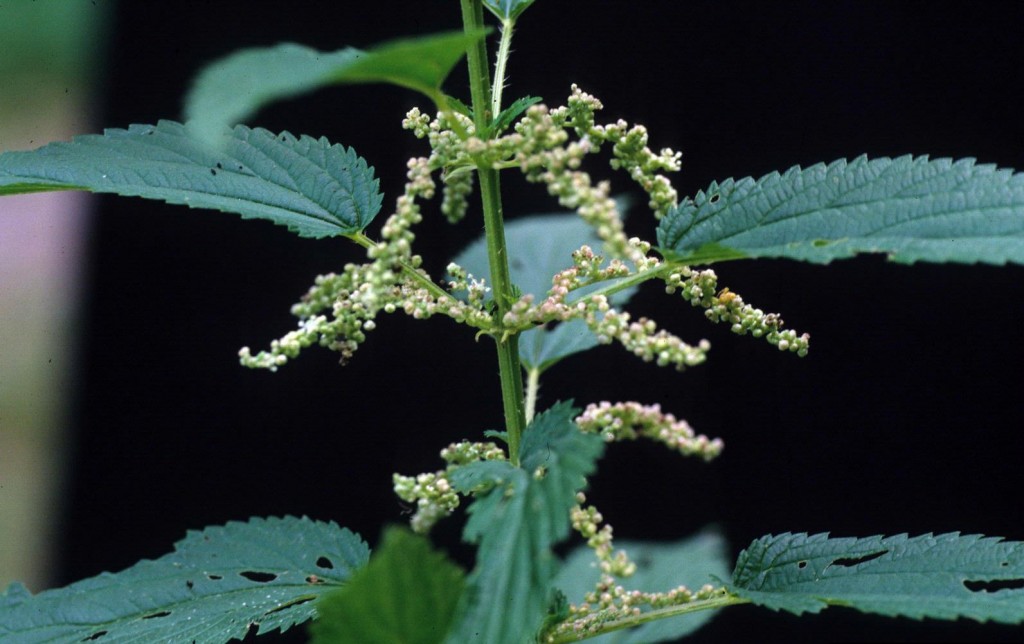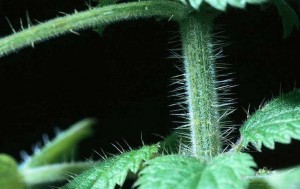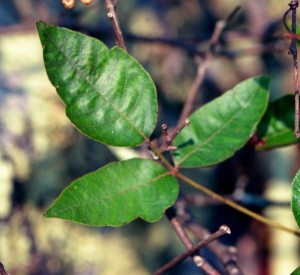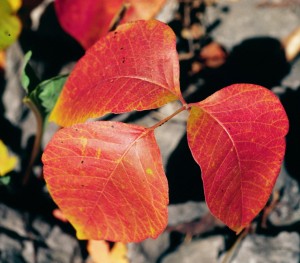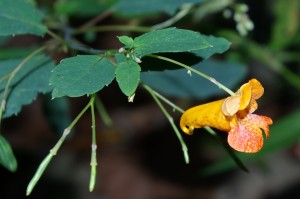Itchy, Scratchy, Stingy? Or Soothing, Snackable?
One causes an immediate “ouch, that hurts!” while the other may take days to elicit a similar response. Both are attractive, almost begging a touch. And, both may be encountered throughout our rich wooded bluff lands, particularly in moist soils along creeks, ravines, and shaded slopes.
Canada nettle (Laportea canadensis), also called “wood nettle” or simply “stinging nettle,” causes the immediate response by the unwary person who reaches out to touch the actually graceful foliaged plant with the fat drooping clusters of small blossoms. The delayed response – usually more irritation caused by an unremitting itch – is due to contact with poison ivy (Toxocodendron radicans), another attractively foliaged plant especially when autumn weather brings out its bright red and orange coloration. But what is it that makes these plants toxic to us?
The very hairy stems and leaves of Canada nettle contain small needle-sharp barbs that can pierce the skin. The intense sting is caused by a complex chemistry of compounds that also form the basis of formic acid, the stinging compound released by some species of biting ants. Many people experience sharp pain from a nettle’s sting with some people, who apparently are especially susceptible, reporting pain for hours and, among a very rare few, reactions that include swelling and pain lasting for days.
Stinging nettles have a wide distribution with members of the family Urticaceae found throughout the temperate zones, including Europe, Asia and North America. A few species of nettle, such as Urtica doica, also known as “stinging” and “wood” nettle, have native ranges that include both Europe and North America. This particular species occurs in Illinois, but only rarely in our area where Canada nettle is common.
As you might suspect such a widely occurring plant with such bad effects has a host of folk stories and a long history. A very toxic form of nettle was supposed to have been introduced into Britain by Romans. Told that the climate of Britain was nearly unendurable due to winter cold, Roman soldiers planted nettles and harvested leaves and stems which they then rubbed into their arms and legs. The belief seemed to be a combination of hope that the ache of multiple stings would help warm them and that their irritated reddened skin would then retain heat.
Heat is the one sure method to remove the sting from nettles. Once processed by boiling the plant losses all its painful chemicals. Nettle stew, boiled nettle salad, and even nettle pudding and nettle beer were among the food uses. Heat processing also allowed nettle textile manufacturing which actually flourished for a short time during World War I in Germany and Austria when raw cotton imports were unavailable. Nettle cloth was said to be very fine and comparable to high quality linen and even silk.
Clothing, however, is the one way that the “ouch” of contact with nettles can be delayed, as many a hiker has sadly discovered. The stinging hairs and barbs can detach onto clothing and then release their stings at a later time.
The ache and itch of poison ivy often doesn’t start until hours or even days after contact with this plant. Oil, called urushiol, contained in all parts of the plant, but especially concentrated in the stems, causes an allergic reaction in most people. The weeping blisters and reddened rash areas are due to the body’s flooding the contact area with histamines.
Only actual contact with the oil – not just walking near a poison ivy plant, or contact with the fluid released from poison ivy blisters – causes the allergic reaction. But, oil from poison ivy can be transmitted on clothing or even by pets or livestock that carry the oil on their coats. One of the more dangerous forms of contact can be exposure to burning poison ivy, as the oil in the plant can be carried in smoke and cause throat and lung irritation. A few people have little to no reaction to poison ivy, but such apparent immunity may not be constant and can change through life or, even, in the course of a year.
Folk remedies for both nettle stings and poison ivy rash, oddly, included using the plants themselves as cures. The juice of a nettle plant, extracted by squeezing the stem, was said to relieve the burn of nettle barbs. Old folk remedies for creating immunity to poison ivy included eating a few early-spring leaves or drinking a tea made from the leaves, a form of “cure” far more likely to cause poison ivy rash in the mouth, throat, or digestive tract.
An old remedy for human reactions to both plants offered the added benefit of ready availability as this curing plant often grows in the same area and even among both nettles and poison ivy. Juices from the leaves and stems of jewelweed, also called spotted-touch-me-not, may relieve the painful acid reaction to a nettle sting. Native Americans also used a poultice made from jewelweed to reduce the rash and itch of poison ivy exposure. Both orange (Impatiens capensis) and yellow jewelweed (I. pallida) grow in rich, moist soils in shady areas and both species can be found in our area, although orange jewelweed tends to be more common. The small, cornucopia-shaped flowers begin blooming in June and continue through September on plants that can reach four feet in height.
The alternate common name – touch-me-not – is derived from the same characteristic that gives all impatiens their scientific and common generic name. These plants are, simply, “impatient” and spread their ripened seed at the slightest touch. The bedding garden varieties of impatiens have been hybridized from species originating in Africa and in Europe, and, as most gardeners know, are wont to spread seed the short distance from pots into gardens. Our native varieties are a bit more exuberant and will explosively eject seed for a several foot distance when a ripe seedpod is touched.
A landscape – or, more properly in our bluff lands – a creekscape dotted with poison ivy, stinging nettle and jewelweed may cause us to sigh and wish away the plants that hurt us. But, the three types of plants also illustrate additional benefits and harms.
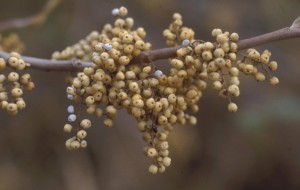
Poison ivy fruits nourish more than 90 species of animals. Ohio State Weed Lab, Ohio State University, Bugwood.org.
Poison ivy berries, small white fruits growing in clusters, sustain and are relished by about 90 species of animals. Nearly all mammals of our area, including opossums, raccoons, squirrels and deer, and more than 75 songbirds as well as quail and turkey eat poison ivy berries. At least two moth species depend on poison ivy foliage as food during their larval, or caterpillar, stages of life.
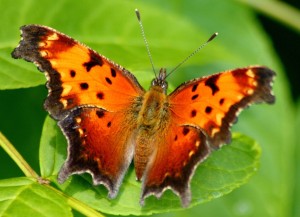
The brightly colored upperwings of an Eastern Comma. David Cappaert, Michigan State University, Bugwood.org
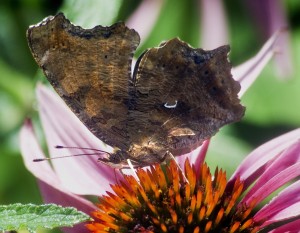
The underwing shows the white "comma" marking of Eastern Comma. David Cappaert, Michigan State University, Bugwood.org
Stinging nettle is the larval food host for several butterfly species, including the strikingly beautiful Red Admiral and the more cryptically colored but still elegant Eastern Comma and Question Mark. Two moth species also rely on nettle during their larval phase.
Our native impatiens also is host to at least two moth species during their larval phase. And, the cornucopia-shaped flowers offer a rich nectar source for hummingbirds, bees and butterflies.
But, while native impatiens may delight us, and hummingbirds, both in color and abundance of bloom and perhaps offer us relief from a nettle’s painful sting, they can have another, very damaging effect. Livestock, including cattle, goats and sheep, can be poisoned if they eat large quantities of jewelweed. For these animals spotted-touch-me-not is a truism rather than a name of playfulness. Beauty – or eatabilty and utility – perhaps is not in the eye of the beholder so much as it is within the nature of the species.
To learn more about plants of our area, particularly those that, like jewelweed, may cause toxic reactions to domestic pets and livestock, the public was invited to a talk with Dr. Dwight Boehm of the Waterloo Animal Hospital. Dr. Boehm’s presentation was on Monday October 4th at the Monroe County Annex Building, 901 N. Illinois St., Waterloo. This presentation was co-hosted by Clifftop and the Monroe County University of Illinois Extension Service and as part of their continuing seminar series “Meet the Neighbors.”
Clifftop, a local nonprofit organization, is focused on preserving and protecting area bluff lands.
A version of this article appeared in the September 17th 2010 edition of the Monroe County Independent.
© 2010 all content rights reserved, Clifftop NFP.
Comments are currently closed.

